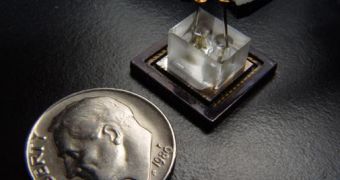Microscopes are not exactly devices you would like to carry around in your pocket all day. They are generally bulky, require proper light sources, are fragile and last but not least, they are expensive. Their place is in the laboratory, not on the road. A new invention could make microscopes not only extremely small and cheap to manufacture, but also very powerful, allowing medics to make quick and precise diagnoses right on the spot.
The device basically consists of a single image-sensing chip, requires no additional optical systems and could be used to diagnose diseases such as malaria, the team said. "Because the image processing that's needed is trivial in computing terms, we could build the microscope into an iPod-sized device with an LCD display. The $10 chip would be a disposable, like an inkjet cartridge, and the whole thing would fit into a clinicians' [sic] back pocket," says Changhuei Yang of the California Institute of Technology, Pasadena.
The couple-charged device image-sensing chip, generally used in the manufacturing of digital cameras, is placed exactly beneath the studied sample in order to produce an image, thus using natural light as light source.
Yang says that he came up with the idea while thinking about a phenomenon known as 'floaters', experienced by humans on a daily basis. A 'floater' is a small piece of debris in the human eye that can be observed as a rough shadow moving through your field of view. The problem is that CCD sensors are not generally built with the resolution required to view objects smaller than 3 micrometers, the size of a typical pixel in commercial sensors.
In order to solve this 'little' problem, the research team thought of creating a setup in which the CCD would be allowed to observe sub-micrometer scale features without modifying the sensor itself. By placing a thin layer of aluminum above the sensor, having 1 micrometer holes over each pixel, they were able to increase the resolution of the device. But the sensor was still able to produce only partial images of the sample.
This last issue was solved by placing the sample in a microfluidic chamber, so that it moved under the influence of the gravitational force or with the help of an electric charge at a known speed, the device thus picturing most of the sample as it passed over the surface of the sensor. The image was then compiled with the help of a computer. "The CCD chip itself costs $10 and the microfluidic part may cost 10 cents," said Yang who thinks the new microscope has high chances of becoming a success on the commercial market.

 14 DAY TRIAL //
14 DAY TRIAL //